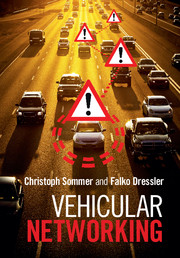5 - Information dissemination
Published online by Cambridge University Press: 18 December 2014
Summary
The objective of this chapter is to discuss data dissemination in vehicular networks in detail. We concentrate essentially on network-layer and application-layer protocols, which are often discussed and developed as a single protocol above the respective access technologies. The key objective is to achieve information exchange between any two vehicles, from one vehicle to all neighboring ones, from one vehicle to infrastructure components, from infrastructure to one or all neighboring vehicles, and dissemination from a vehicle to all those that are interested in the content.
We start by looking at ad-hoc routing protocols that were suggested in the early days of vehicular networks. Having identified their limitations, we explore alternatives, starting with geographic routing and geocast as communication primitives, and then exploring one of the most promising domains in the scope of vehicular networks: beaconing or one-hop broadcasting. In this framework, this chapter details the basic principles underlying such inter-vehicle communication (IVC) approaches, namely unicast, local broadcast, anycast, and multicast communication principles as used in vehicular networks. We of course investigate the current state of the standardization efforts, primarily focusing on the European Telecommunications Standards Institute (ETSI) standardization towards cooperative awareness messages (CAMs) and decentralized environmental notification messages (DENMs) as well as the ETSI GeoNetworking initiative. Furthermore, we explore options for exploiting available infrastructure such as roadside units (RSUs) or even parked vehicles to provide access to some backbone network or to help spread information among the vehicles. We conclude this chapter with a discussion of delay/disruption-tolerant network (DTN) approaches and the use of concepts known from Internet-based peer-to-peer networks.
This chapter is organized as follows.
• Ad-hoc routing (Section 5.1) – We start by exploring classical mobile ad-hoc network (MANET) routing algorithms in detail, because some basic knowledge of ad-hoc routing is needed in order to understand the more sophisticated vehicular ad-hoc network (VANET) routing options. In this section, we also discuss the applicability of MANET routing to VANETs as well as the specific challenges resulting from the underlying mobility pattern and delay constraints for vehicular safety applications.
[…]
- Type
- Chapter
- Information
- Vehicular Networking , pp. 136 - 228Publisher: Cambridge University PressPrint publication year: 2014



